EXPLORE THE ROLE OF THE TITLE – LOCATING TITLES
From a contextual point, I am asked to focus on the conceptual work, An Oak Tree, by the artist, Michael Craig Martin. I have to consider the relationship between the objects, the title, and the text. Notes will be made below in which I discuss my interpretation of the piece.
I could not open this link! It seems, after a google search I get the idea that An Oak Tree, is a small glass of water perched on a shelf that’s drilled into the wall. The work was first shown in 1973
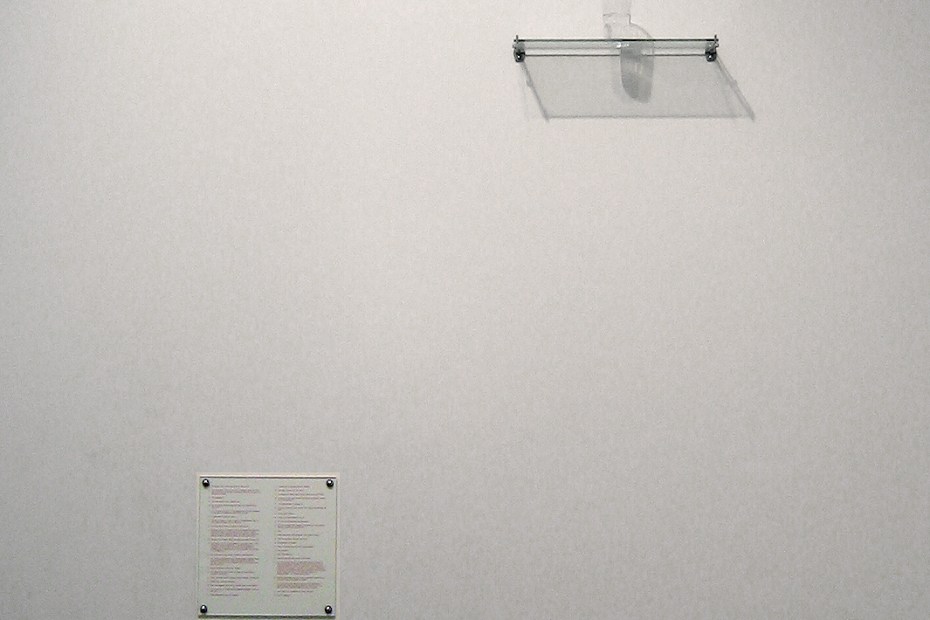
Considering the objects here is:
- a small glass, filled with water, on a shelf
- a glass shelf,
- it is placed in a gallery,
- there is text attached to the wall,
- the text is in Question/Answer format
My thoughts at this stage: whilst working and reading around words and busy finding my way with words, the military invasion (war?) starts in Ukraine. Words change meaning by the moment – I do not know what to trust, believe Words said or written can be forgotten, and filtered, and I learn about manipulation, disinformation, power, intent, etc, and the knowledge that one always needs is about context. This is all very confusing! I do feel this is what is happening with my efforts at an interpretation of this work. I need to read – the text and more, I am not sure that by looking at the work I can make the connections between the objects, the title, and the text.
I find an online blog discussing the work and these words jump at me: Michael Craig-Martin said about an ‘Oak Tree’, “I was trying to work out what was the essence of a work of art. I thought it had to do with suspension of disbelief. You get it in theatre – why not in art?” (Stuart Bush blog on stuartbushstudio.com)
In a way I feel at least I am on the same page – confuse the viewer? But then, does conceptual art not imply that the work stands up by itself, its skill and beauty…? Should I consider comparing this artist with Duchamp, I go to Tate for an answer: Conceptual art is art for which the idea (or concept) behind the work is more important than the finished art object. It emerged as an art movement in the 1960s and the term usually refers to art made from the mid-1960s to the mid-1970s. (Tate website https://www.tate.org.uk/art/art-terms/c/conceptual-art)
On the Tate website, I find more information about Oak Tree. (I also thought the shelf looks like an old-fashioned bathroom shelf with a glass of water on it!) The glass shelf is always placed on a wall at about 9f high, out of reach, you can see it, but you cannot touch it. I copied the following text from their website:
“An Oak Tree is based on the concept of transubstantiation, the notion central to the Catholic faith in which it is believed that bread and wine are converted into the body and blood of Christ while retaining their appearances of bread and wine. The ability to believe that an object is something other than its physical appearance indicates requires a transformative vision. This type of seeing (and knowing) is at the heart of conceptual thinking processes, by which intellectual and emotional values are conferred on images and objects. An Oak Tree uses religious faith as a metaphor for this belief system which, for Craig-Martin, is central to art. He has explained:
“I considered that in An Oak Tree I had deconstructed the work of art in such a way as to reveal its single basic and essential element, belief that is the confident faith of the artist in his capacity to speak and the willing faith of the viewer in accepting what he has to say. In other words, belief underlies our whole experience of art: it accounts for why some people are artists and others are not, why some people dismiss works of art others highly praise, and why something we know to be great does not always move us.” (Quoted in Michael Craig-Martin: Landscapes, p.20) I learn that the text which accompanies An Oak Tree was a deliberate add-on. By placing it below the work the artist wants the viewer to engage with his thought process around the fundamental things about art. To him, it is about language which he uses to interpret the things he makes. A viewer should look at all his work with this in mind – it is ‘his language’ in a certain way. I cannot say that I am less confused…. but at least I have also learned that the artist is known for his interrogation of language, perception, and symbols. When looking at objects he would consider traditional signifiers, the things in our minds, that help us to make sense (even if it is a religion) I understand it also a saying something about the power of words in our ways of thinking.
METHOD
I have to argue that most of the time when I view art, I do not want to know the title of a work – I prefer my own firsthand experience and then hear/read the artist’s input as well as their own position on the subject of the work (on the why and how not always available) This idea was also strengthened by recent participation in a Silent Crit session as arranged by the Fine Arts department of the OCA. Text next to work or a title can (sometimes) take away my own experience, as it can influence my understanding. I do like the idea of documenting works – the archiving system can work. Visiting local art galleries one is influenced by social media marketing and has some information with regard to the title of the exhibition and the artists participating.
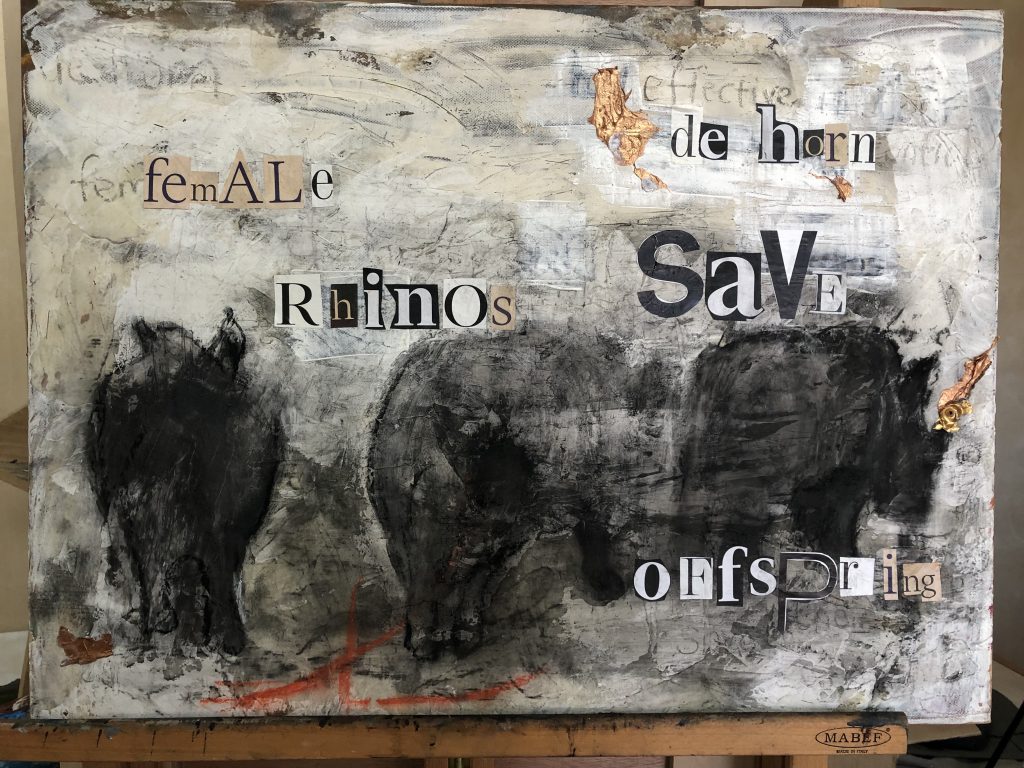
As a form of looking at my own work and exploring the role of the title, I start with a work I presented for a recent silent crit, on 9 March 2022. (OCA Silent crit with a tutor, Lydia Halcrow) I will share the comments of the participants below.
- My Rhino practice (this student knows about my blog) now moving into text, the word FEMALE pulls the viewer into work.
- Then the other words are viewed with the images of the rhinos – a sense of hovering, that they are disappearing.
- Images give a sense of hovering on the edge – awaiting.
- Powerful – the text and title
- Layers are seen – colours and text
- Red-orange line – it is there
Generating titles:
Considering reviewing my titles as part of this exercise
After looking at the work of both MC Martin and On Kawara I think a sense of place as time can be used in some of the works I have done in this course. I have not really explored landscape painting, but places and fragments of things/objects and memories are always intriguing to me. Whilst working through this course and doing my Parallel Project, I became aware of the Fungal Kingdom, and the world of hyphae, mycelium, mushrooms and lichen became part of my daily ‘landscape’, which was mostly around shapes, forms and colours I found interesting within in these organisms. I became more aware of these ‘living things’ being part of the ‘invisible’ landscape. At times I found it difficult to place myself into this natural landscape, as I realise the destruction our footprint has caused, but then being at the coast and finding the lovely lichen on coastal plants and rocks, or fungi in my veggie patch, made me aware of the fine balance that exists around me., and that I am part of nature. Looking at work and titles, I feel the need to do more landscape and still life paintings of these objects I viewed and researched, as it reminds me not only of place but of resilience, hidden and or untamed places, different seasons, survival, things entwined, alliances, repetition, things sometimes unseen that will remain long after I am gone and decomposition and death as part of life.
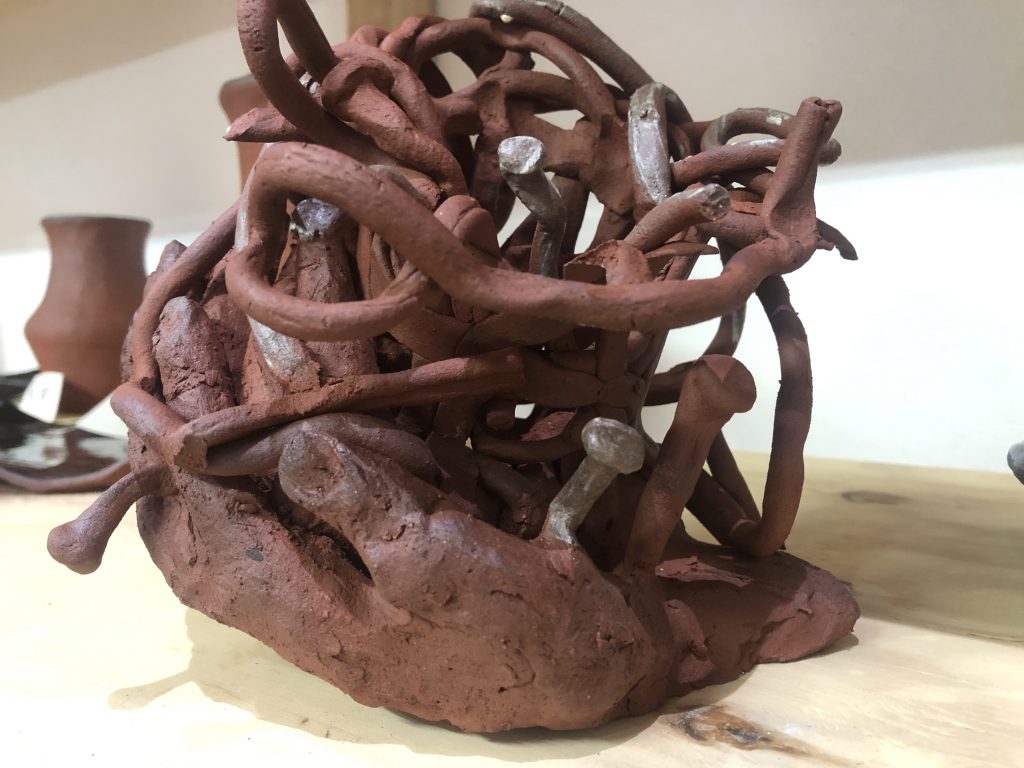
After I read the poem, Mushrooms, by Sylvia Plath I felt this work can stand for the struggle for women’s rights. Plath, a feminist, used mushrooms as a metaphor for community, equality, and the voiceless.

Gestural marks translated to forms, female subjects
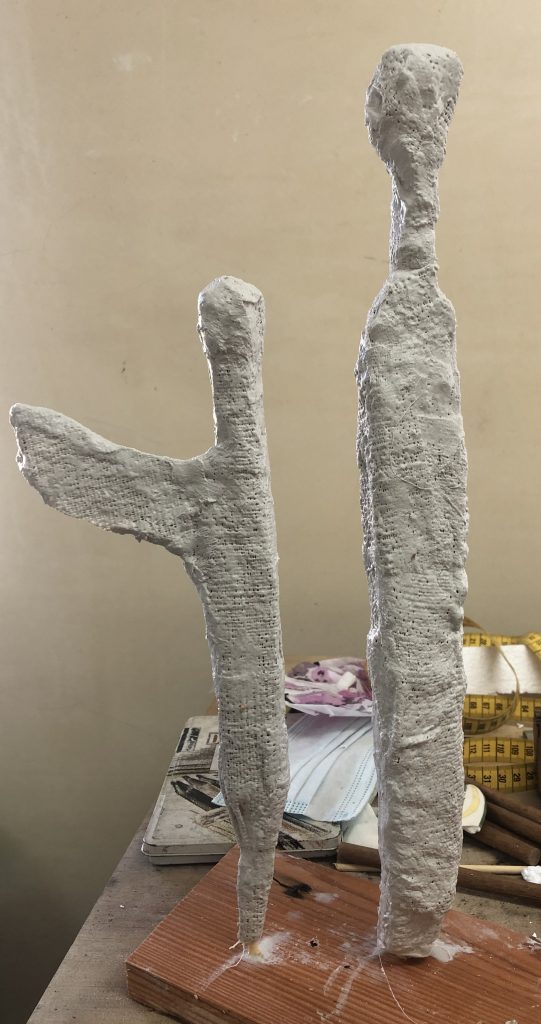
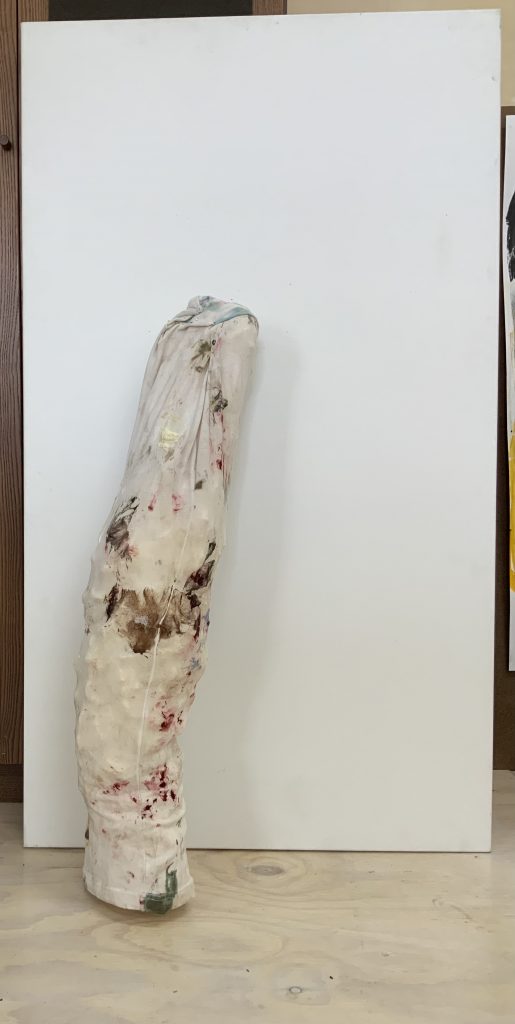
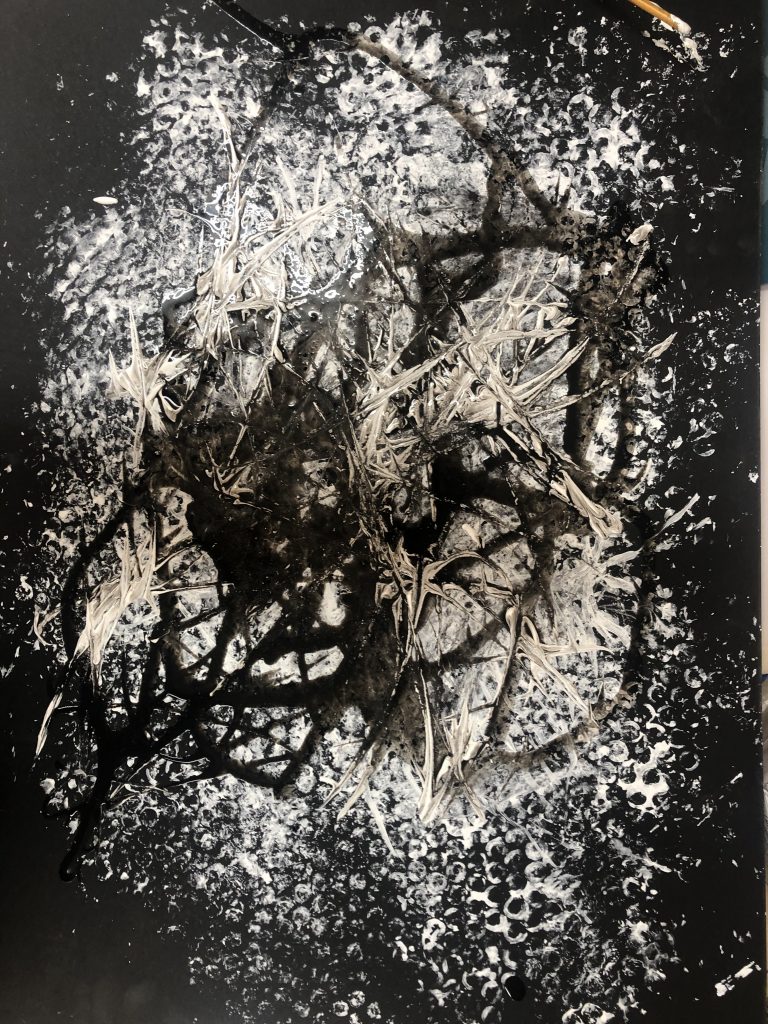
Lichen made me aware of how many things are invisible in our landscape, and that we need to stop and really look – take the time and experience the place.
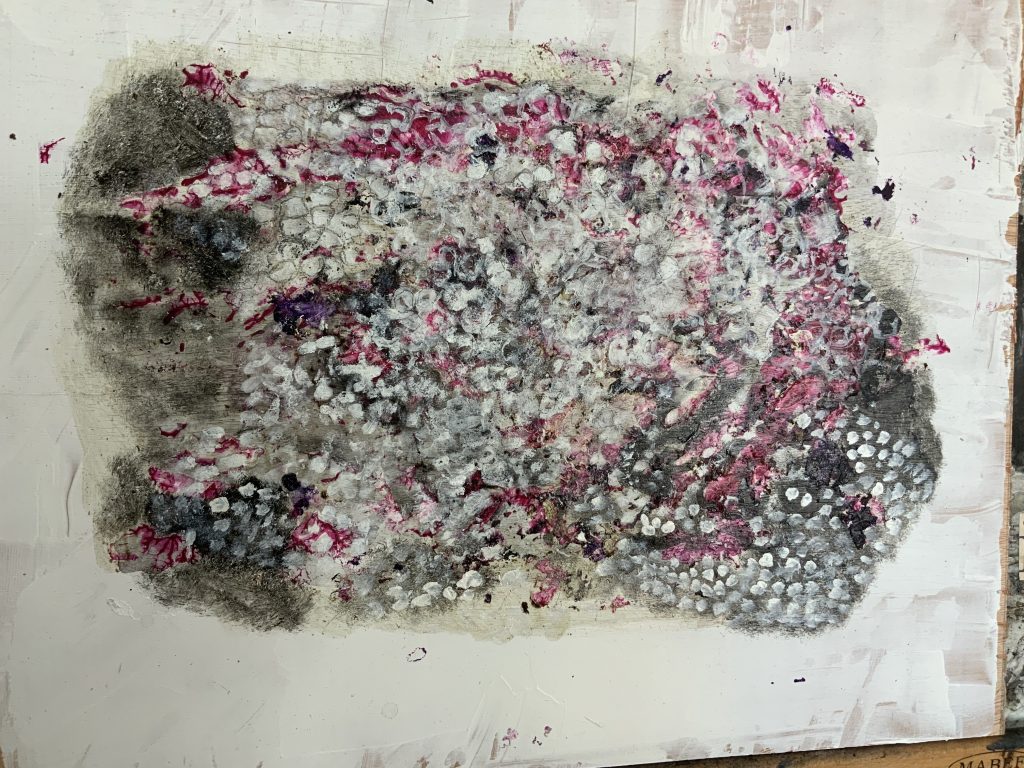
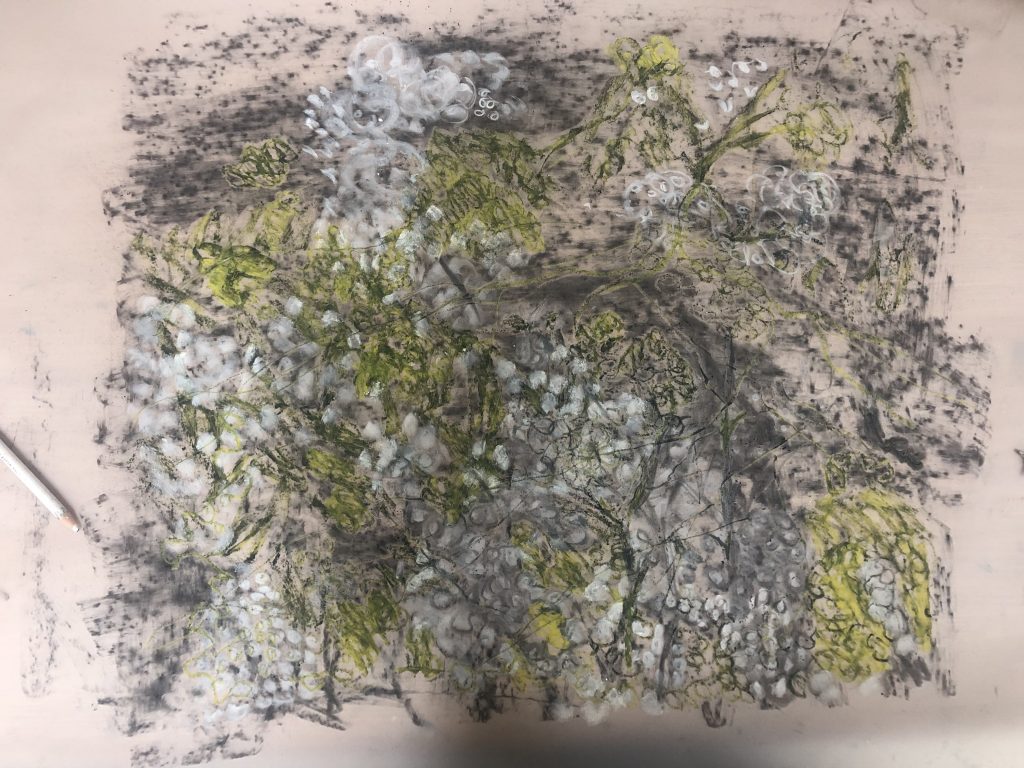
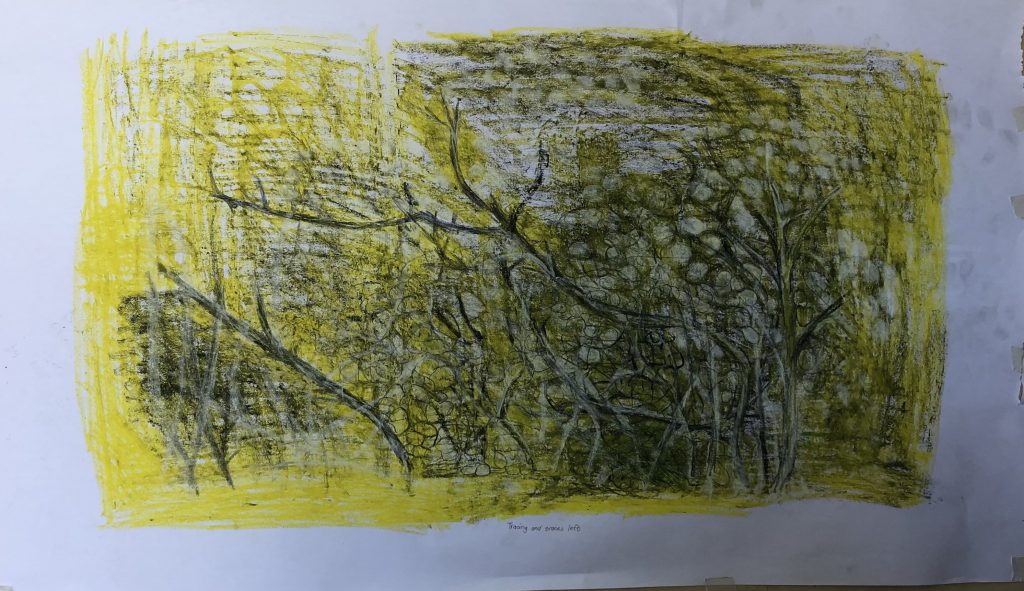

I also attempted a written piece of work, Entanglement:

EXERCISE 3.1
On Kawara
The Artsy website I think describes this artist and his work best:” On Kawara is famous for his “Today” series of paintings that depict the date of their completion in the language and dating conventions of the country in which they were completed. The artist always boxed the canvases, often including a newspaper clipping from the recorded day. Kawara worked on the series from 1966 until his death in 2014; through this persistent practice, he explored the experience and documentation of time. In his books, paintings, and drawings, Kawara attempted to capture time as a function of human experience, often involving himself in process-based approaches that became extensions of the pieces themselves.”
Interesting is that the works in this series were made on the date referred to in the title, and if they are not finished by midnight of that date, they were destroyed. He created more than 2,000 date paintings in total, in more than 100 different cities. His Date Paintings was a monochromatic canvas of red, blue, or grey with the date on which it was made inscribed in white. These Date Paintings range in size from 8 x 10 inches to 61 x 89 inches, and I think one could also see the naming of titles as part of a repetition process., which also had rules which the artist followed. Kawara began producing boxes for his Date Paintings and lining those boxes with newspaper clippings that were derived from the daily press. I learned that on the day of making the image in the study material (p100), a rocket scientist was killed by a foreign-made .25 calibre pistol, in Columbus, Ohio. Knowing this about the idea around the title takes me into his life and how he shared repetitive experiences of a day at a specific place. In it, I feel I can also ‘read’ his thoughts when he made this work – here is a narrative at play about that day. I wonder why he travelled so extensively during his working life or was it part of his project for his working life? Is he not sharing something that is living – in the sense that every day that one lives, is followed by a previous day – a type of ongoing, a happening? Could he be trying to bring the moment (life lived) as meaning to the viewer? I read that it took him many hours to finish these works – so in a way, it captured his work process, which can be seen as a daily routine.
Reading a bit more, I found the following: “On Kawara would develop a practice that revealed a new twist in the nexus between philosophical meaning, aesthetic perception and the movements of the cosmos.” ( N. Papastergiadis: https://www.afterall.org/article/space_time_matter-and-motion-in-on-kawara) I learned that On Kawara also had a series done with postcards, in 1973, he dispatched I Got Up (1968–79) postcards from 28 cities. It becomes clear travel was never an interruption, he documented the flow of time and also helped the viewer to trace his travels in this series. When I think about that act of painting, which in this case was contained within the space of a day, it takes me to how making is also a sharing of the intent and focus of the artist depending on the size—four, five, six, seven hours to produce. When I consider repetition as a game, I found a surprise about this artist, namely that he financed his travels from his winnings in the game of mah-jong.
I think what I also value, is the artists’ dedication to the practice of painting. It was a repetitive process – something ongoing, work that apparently took him depending on the size, between four to seven hours to produce. There is a form of quietness that I experience in his work, which I would love to explore myself. I like the idea that each day is different for every person and it makes me think about my day and how I keep track of every day. My blog is in many ways a reflection of what I do as I work through my studies and make work, accordingly, but here is more due to the fact that it is diarised and it leaves space open for any viewer to interpret.
DEVELOP ONE OF THE TITLES INTO A SERIES OF TEXT PIECES
Tracing and traces left
Video of making
I should tell the viewer How Yellow and Pink became my go-to colours in my mostly monotone creative world. I found my way to these colours by slowly adding them to my charcoal making. By experimenting with techniques such as decalcomania and frottage I could explore creating textures that remind me of moments of memory which does not only imply seeing but experiencing the medium by using my fingers, hands, and even feet to touch and manipulate, (smearing with my fingers into the medium). All of these are seen as traces of something that happened and something being left behind on the support. The marks left on the paper or other support stay a reminder of something I connected with but can be absent or exist, be it a memory or an encounter.
In the work below I used my index finger to make charcoal marks on the paper by dipping my finger into the Charcoal powder and then pressing it into the paper support. I used acrylic paint to follow some of the lines with a thin brush to create lichen marks on the support. I added white acrylic paint but found erasing around the objects, and made them come to the front as separate from the ground drawing. This work happen over a time of thinking and looking at close-up photo images of the lichen I collected. In these forms, I found mushroom shapes and rounded shapes, which remind me of my own fingerprint, of how lichens came to be by joining up with fungi.
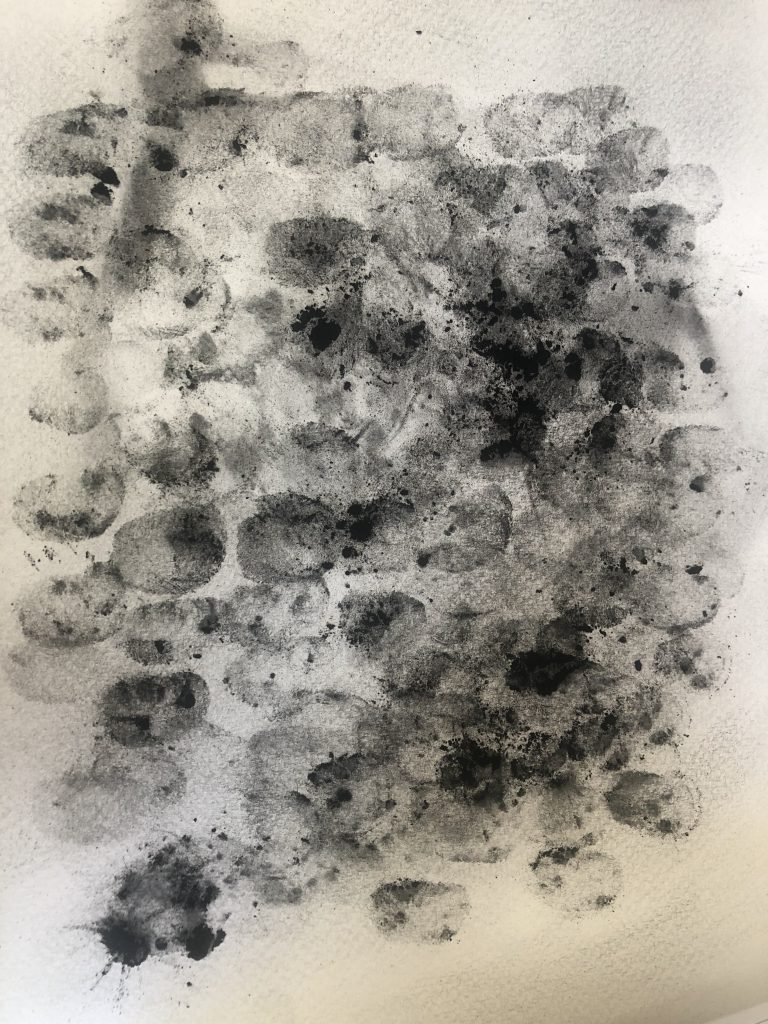

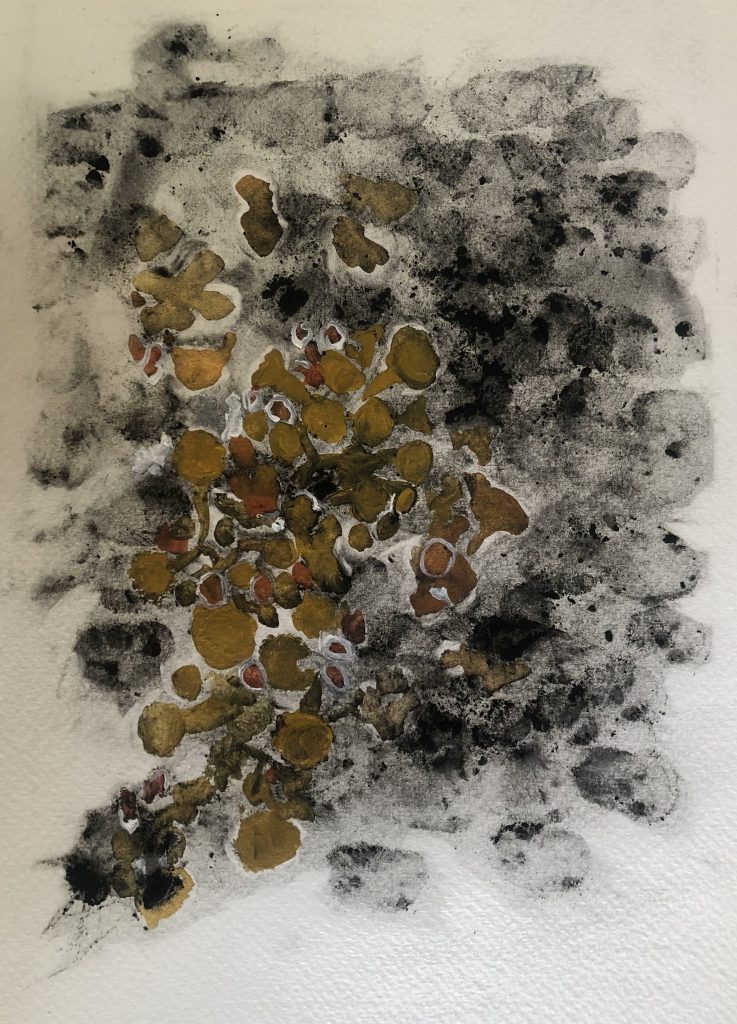
I think this work can be seen as a short study around Indexes. A video shows how the work came together and I added two short Hyko poems about my making:
HYKO 1
Something left behind – what is left?
A reminder of touch.
HYKO 2
Moments and memories, holding on.
letting go.
Reflection on this exercise
I have not used many titles in my work up to now. I did use it when I did the drawing series of the Rhino studies and realise how I needed to explore the involvement with the subject of rhino poaching and our role as consumers of natural resources and how we view nature.
With regards to work I did in my Parallel project I think it is important as a way of archiving the making process, the different materials I explored and the thoughts or narrative that was in my mind.
List of illustrations
Fig. 1 Craig-Martin, M. (1973) An Oak Tree. [online image] Viewed at: https://artspace.com/magazine/interviews_features/book_turning-water-into-an-oak-tree-michael-craig-martin-discusses-performing-a-miraculous-act-of-55188 (Accessed on 02/03/2022)
Fig. 2 Stander, K. (2022) Will they listen? [Mixed media and text , size 45 x 61cm, acrylic paint, collage on canvas] In possession of: the author: Langvlei, Riebeeck West.
Fig. 3 Stander, K. (2022) My gift to Sylvia Plath. [clay sculpture] In possession of: the author: Langvlei, Riebeeck West.
Fig. 4 Stander, K. (2022) Veil Untitled after Cy Twombly. [painting] In possession of: the author: Langvlei, Riebeeck West.
Fig. 5 Stander, K. (2021) She Angels. [3d sculpture with plaster of Paris] In possession of: the author: Langvlei, Riebeeck West.
Fig. 6 Stander, K. (2022) Standing in for.. [3d sculpture with expansive foam and cotton] In possession of: the author: Langvlei, Riebeeck West.
Fig. 7 Stander, K. (2022) Monochrome Engantlements. [acrylic painting on board] In possession of: the author: Langvlei, Riebeeck West.
Fig. 8 Stander, K. (2022) Colour Memories no 1. [acrylic and charcoal on board] In possession of: the author: Langvlei, Riebeeck West.
Fig. 9 Stander, K. (2022) Colour Memories no 2.[acrylic an charcoal on Velour paper] In possession of: the author: Langvlei, Riebeeck West.
Fig. 10 Stander, K. (2022) Tracing and Traces Left. [oil pastels, chalk and charcoal on paper] In possession of: the author: Langvlei, Riebeeck West.
Fig. 11 Stander, K. (2022) Imprint. [acrylic ink and medium on paper] In possession of: the author: Langvlei, Riebeeck West.
Fig. 12 Stander, K. (2022) Entanglement [biro on graphic paper] In possession of: the author: Langlvei, Riebeeck West.
Fig. 13 Stander, K. (2022) Indexing. [study with charcoal and acrylic on Fabiano paper] In possession of: the author: Langvlei, Riebeeck West.
Bibliography
Artsy. net website description of On Kawara and use of titles. Available at: https://www.artsy.net/artwork/on-kawara-title ( Accessed on 10/03/2022)
Morgan, Zach. 2017 An Oak Tree and the Essence of Art [online article] https://dailynexus.com/ (Accessed on 01 March 2022)
Plath, Sylvia. (1960) Mushrooms poem [Online reading of poem] https://www.bl.uk/learning/langlit/poetryperformance/plath/poem1/plath1.html (Accessed on 01/03/2022)
Tate (2020) “An Oak Tree”: Michael Craig-Martin, 1973 [Tate online] Available at: tate.org.uk/art/artworks/craig-martin-an-oak-tree-l02262 (Accessed on 03/03/2022)